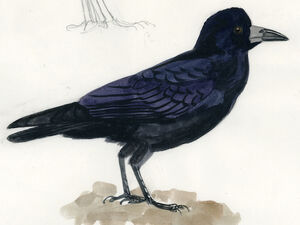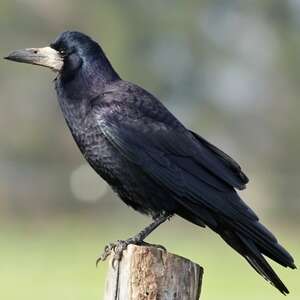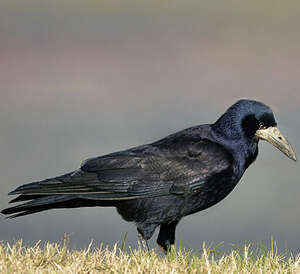Rook
Corvus frugilegus - Corbeau freux
Identification
The Corvid family includes the largest known passerines, the aptly named Great Raven being the largest. The Rook is smaller but still measures between 45 and 50 cm in length, with an average wingspan of 90 cm. The proportions are similar, and the silhouette too, but with the tail simply rounded at the end. From afar, it can be mistaken, but fortunately the voice is very different, as discussed further on. Confusion with the Carrion Crow is possible, but again the voice can be used to differentiate. It is slimmer and more elongated than the crow, and its gait on the ground seems a bit awkward. In flight, the crow has wings that are wider but shorter than those of the rook, and the tail is shorter. The silhouette is peculiar, with the back tapered due to the long wings pointing towards the end of the tail. The head does not have the roundness of that of a crow, but usually shows a convex forehead. But what stands out at reasonable distance in the case of the nominate subspecies that concerns us is its beak, grey, long and pointed, sometimes slightly curved. It is so obvious that it almost obscures the head. Its base is covered with light grey naked skin both above and below. The plumage is entirely black, lustrous, with a blue or purple sheen in the sun. The eyes and legs are black, the latter having elongated trousers. The male is slightly bigger than the female. The pastinator subspecies from the east of the continent differs from frugilegus in its feathered rather than bare face, and therefore it is important to take a good look at the beak shape. The juvenile can be mistaken for a crow, and it is important to look at the head. The beak is the same as that of the adult, long and pointed, but it is black and the culmen is covered for half of its length with bristles, as in the case of a crow.Therefore, one must be very vigilant. Fortunately, the voice and gregarious behavior of the Rook is an appreciable help. A young Rook always has adult birds around him.
Subspecific information 2 subspecies
- Corvus frugilegus frugilegus (Europe to c Asia)
- Corvus frugilegus pastinator (e Asia)
Foreign names
- Corbeau freux,
- Graja,
- gralha-calva,
- Saatkrähe,
- vetési varjú,
- Roek,
- Corvo comune,
- råka,
- Kornkråke,
- havran čierny,
- havran polní,
- Råge,
- mustavaris,
- graula,
- Bláhrafn,
- gawron (zwyczajny),
- krauķis,
- poljska vrana,
- Грач,
- ミヤマガラス,
- 秃鼻乌鸦,
- råka,
- 禿鼻鴉〔禿鼻烏鴉〕,
Voice song and call
The contact call, typical for the Rook, is a very harsh and unpleasant raaarrh to the human ear. Its nasal tone is different from the crow's call, but the difference may not be evident to an untrained ear. The call is less loud and aggressive. Behaviour can help to distinguish them. Rooks are usually found in groups whereas crows, which are territorial, go in pairs. The rook's call can soften to a nasal hiiiin. The young ones in the nest demand loudly with high-pitched and raspy heiiinns.
Habitat
In Europe, the Rook is a species of the plain, mainly inhabiting large alluvial valleys and the first plateaus, locally reaching up to 500 m altitude.
Behaviour character trait
The most obvious character trait of the Rook is its gregariousness. It is mostly observed in groups. This gregariousness reaches its peak in the winter season when wintering birds gather at night in large flocks containing thousands of individuals.
The Rook usually keeps the company of Jackdaws in such gatherings, both during the day and at night. There's a special affinity between these two species, which often nest in the same trees. Common Ravens sometimes join them while foraging, but not as a rule. During rest periods, the Rooks gather in trees and have lengthy conversations. When one pays close attention to these groups of Rooks and Jackdaws, one is surprised to see how orderly they are. They stand by pairs in flight or at rest, and not just during the breeding season. This gives us a glimpse of the strong bond that exists between couples. Another amusing behaviour which easily draws our attention at the end of summer is their fondness for breaking nuts. Towards the end of September and early October, when the nuts reach maturity, the Rooks come to harvest them from the trees, then try to open them to get to the kernels which they consume. As their beak is not powerful enough, they drop the nuts from a height onto a hard surface, usually a tar road. They keep doing it until the nut finally cracks, which might take quite a lot of time. This is indicative of their appetite for this fruit. If it's a busy road, it can be rather fun to watch the birds dodge the cars and fly back to their nut. If, by chance, a car runs over a nut, the Rook gets an immediate reward.Flight
The long wings and long tail of the Rook provide it with great agility in flight. It often has the opportunity to show this off during group flights above colonies or roosts, or even just for fun when the conditions are right. While the flight may be erratic in these cases, it is swift and direct between the colony and foraging areas during nesting.
Dietfeeding habits
The Rook feeds on the ground which it traverses with its gangly gait, almost always in a group. It is an omnivore, much less inclined to necrophagy than some of its relatives.
It mainly feeds on invertebrates from the ground such as earthworms or tipulid larvae, which it prises with its powerful, pick-shaped beak. The vegetable part of the diet includes seeds, especially cereals, left on the field after harvesting or scattered around silos, and many more seeds, especially in the bad season. It has a taste for the germinating seeds, including those that are beginning to break through in the fields, which are the reason for the scarecrows seen here and there full of lamentable Rooks hanging from a string. But this is a bit of ancient history. The example of the nuts given earlier illustrates well this appetite for the plant's forms of resistance. In addition, the Rook can feed on many other items found on the ground, small vertebrates such as young amphibians or lizards, various insects, eggs and young birds found in ground nests like those of the Field Lark, etc. But overall, these complements only constitute a small part of the diet. When they feed their young in the spring nest, the adults store food in their gular pouch to avoid unnecessary back and forth between colony and foraging areas. This pouch can swell enormously and become very visible (see photos).Reproduction nesting
The Rook is an exclusively colonial species for reproduction. A colony may count a few nests only or even thousands depending on the environmental conditions. In a beautiful colony, some nests are almost nested within each other so much that their density can be important. There is therefore no really territory for this species. Trees are often chosen as nesting sites, poplars, planes and other chestnut trees, so often near the human, for example in an urban park. A colony is perennial and reoccupied year after year as long as the bearing trees are healthy.
The nests themselves are refurbished if necessary. The nest is a large heap of twigs collected on the ground or picked from trees. This heap provides a consolidated cut with mud and lined internally with fine elements such as rootlets. All very corvid. Both sexes are active in construction, the male bringing the materials that the female arranges. For sedentary birds, nesting begins early, as early as March. At this moment, the frenzy of the rooks does not go unnoticed. Group flights punctuated by many shrill cries attract attention. The female lays an average of 4 eggs (2 to 7) light green spotted with sepia or gray which she incubates alone for 16 to 18 days. The young, nestlings, stay in the nest for about 6 weeks, fed by both parents. After which they stand in the trees where they continue to be fed until they can safely fly, around 45 days. The family will remain bonded for another 6 weeks before the young emancipate, feeding together in the gleaning areas and returning to the colony at night. There is no second brood.In Russia, breeding only begins in May.Geographic range
The Rook's breeding area extends almost continuously from the Atlantic Ocean to the Pacific in temperate latitudes on the Eurasian continent. The boundary between the two subspecies passes through Mongolia. It is very local both to the north, for example in Fenno-Scandia, and to the south in Mediterranean climate, for example in Spain. It is absent in Italy and the Mediterranean Islands. The birds in the north of the area are migratory and spend the winter in the south of Europe, in Central Asia up to the north of the Persian Gulf and in China.
Threats - protection
IUCN conservation status
concern
in the Wild
threatened
evaluated
The nominal subspecies of the Rook is common and abundant, not threatened at all. On the other hand, the orientale pastinator subspecies has dropped enormously in the last century and is currently rare to uncommon.
Sources of information
- IOC World Bird List (v15.1), Gill, F and D Donsker (Eds). 2025-12-07.
- Les passereaux d'Europe, tome 1, P. Géroudet, M. Cuisin
- Birds of the World, The Cornell Lab of Ornithology
- xeno-canto, Sharing bird sounds from around the world,
Other sources of interest
 Specification sheet created on
18/07/2023 by Jean François
Specification sheet created on
18/07/2023 by Jean FrançoisTranslation by AI Oiseaux.net
© 1996-2025 Oiseaux.net
- Accipitriformes
- Aegotheliformes
- Anseriformes
- Apodiformes
- Apterygiformes
- Bucerotiformes
- Caprimulgiformes
- Cariamiformes
- Casuariiformes
- Charadriiformes
- Ciconiiformes
- Coliiformes
- Columbiformes
- Coraciiformes
- Cuculiformes
- Eurypygiformes
- Falconiformes
- Galliformes
- Gaviiformes
- Gruiformes
- Leptosomiformes
- Mesitornithiformes
- Musophagiformes
- Nyctibiiformes
- Opisthocomiformes
- Otidiformes
- Passeriformes
- Pelecaniformes
- Phaethontiformes
- Phoenicopteriformes
- Piciformes
- Podargiformes
- Podicipediformes
- Procellariiformes
- Psittaciformes
- Pterocliformes
- Rheiformes
- Sphenisciformes
- Steatornithiformes
- Strigiformes
- Struthioniformes
- Suliformes
- Tinamiformes
- Trogoniformes

































